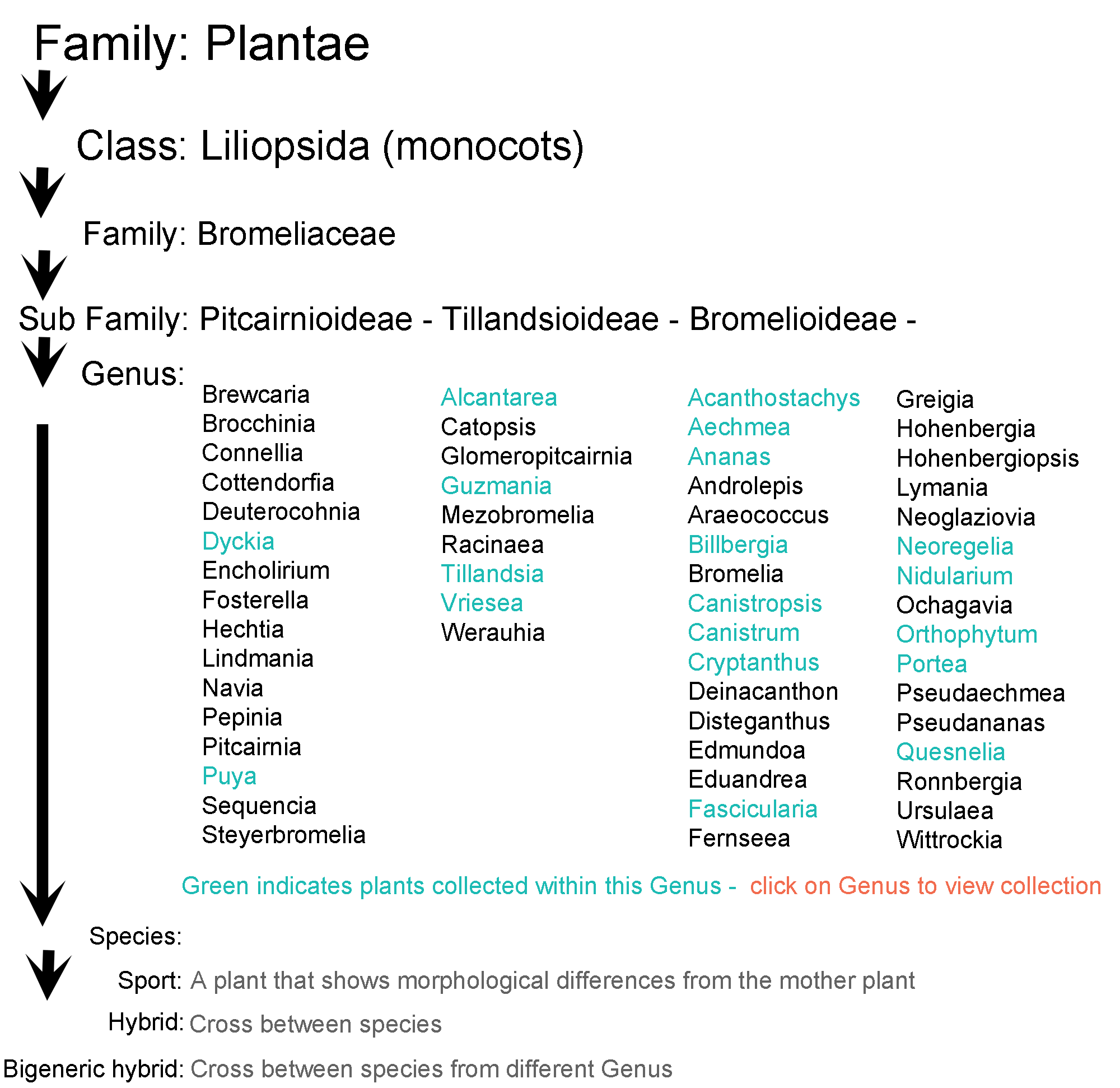A
catalogue of Bromeliads used for various projects by - © Lloyd Godman
This
is a catalogue of bromeliads used by Lloyd godman for his various installations
and photosynthesis projects - the collection of pants he accessed in
New Zealand from 1996 - 2004 was collected from a wide range of sources,
while most were brought from Greens Bromeliads, some were also donated
by the Dunedin Botanical Gardens. Later in 2004 these plants were either
sold or given away with his move to Australia.
Lloyd is at present re-establishing his collection where he now lives
in Melbourne.
A
Lexicon of Bromeliads: A
resource by Lloyd Godman
Genus - Billbergia :Sub- family- Bromelioideae: Family - Bromeliad
Blthough Billbergias produce flowers that are shot lived, they are very spectacular. These very hardy plants often have few leaves but they form in such a manner as to produce tall tubular structu res that hold deep reservoirs of water. These leaves are often dusted with silver bands, or the plant may take on an over all silver dusting. They like average to warm temperatures (60-85 degrees C, 16-30 degrees F), but some will tolerate temperatures near freezing for short periods. Many grow well as epiphytes on trees.
Plants are marked NZ for those collected in New Zealand - or Aust - for the new plants collected since coming to Australia
Taxonomy
Taxonomy (systematics) is the science of classifying plants and animals by evaluating shared features and organizing them into a hierarchy based on these relationships. The basic taxonomic units or taxa (singular: taxon) are species. Every species is given an internationally recognized two part name (binomial) by which it is known. The first part of this name is called the Genus and the second part the Species. More closely related plants within the family, which share some general/generic features, are grouped in the same genus thus the genus/species describe the taxon generically/specifically. Unlike common names which can vary from region to region, a species' binomial name is unique and precise. The name is usually derived from Latin or Greek (or a modern word that has been Latinized). Genus names are always capitalized and species names always start with a lower case letter. Species names often are descriptive (xanthocalyx - with yellow flowers), indicate a place of origin (brasiliensis - from Brasil), or are honorific, named after the collector or other person worthy of the the honor of being immortalized in the taxonomic nomenclature (fosteriana - in honor of Mulford Foster).

Family: Bromeliaceae
Bromeliads belong to the family Bromeliaceae and are members of the Class Liliopsida (monocots). Monocots comprise one quarter of all flowering plants and include some of the largest and most well known groups of plants: orchids, palms, grasses. Traditionally the family Bromeliaceae has been divided into three subfamilies: Pitcairnioideae, Bromelioideae and Tillandsioideae.
Pitcairnioideae |
This subfamily contains the most ancestral bromeliads and many resemble the grass family from which they evolved. Almost all are terrestrial and rely on an extensive root system for their moisture and nutrients. They are generally spiny leaved and have dry capsules with small wingless seeds. |
Bromelioideae |
This subfamily is the most diverse containing the greatest number of genera (but the least number of species). Most species in this subfamily are epiphytic and characterized by a rosette-like form many forming a water holding tank. They generally have spiny leaves and berry like fruits containing wet seeds which are often distributed by birds and animals who consume the fruits. |
Tillandsioideae |
This subfamily contains very few genera but includes the most number of species. Most of the members of this subfamily are epiphytes. All have spineless leaves and their fruit is a dry capsule containing winged seeds which are usually dispersal by breezes. The feathery plumes also help the seed to adhere to a suitable epiphytic surface for germination. This subfamily has special adaptations for survival in very dry (xeric) conditions. |
Recent studies (most prominently the one cited below) have used DNA analysis to examine the relationship between the genera of Bromeliaceae. The results confirmed that the Tillandsioideae and Bromelioideae subfamilies are monophyletic (derived from a single ancestral form). Pitcairnioideae, however, was found to be paraphyletic and required five new groups to be split from it in order for Pitcairnioideae and the newly created subfamilies to all be monophyletic as well. This new reorganization of the genera within the most ancestral subfamily (Pitcairnioideae) hopefully now comes closer to representing their true evolutionary (phylogenetic) relationships.
As part of the DNA sequencing it was determined that the monospecific genus Ayensua (containing only Ayensua uaipanensis) actually belonged in the genus Brocchinia. Additionaly, another troublesome species (Brocchinia serrata) was found to have no relation to the other members of its genus and was separated into a newly created genus Sequencia. So while Ayensua was lost in the new organization the number of genera remains at 58 with the addition of Sequencia (the name a tribute to its origin as a result of DNA sequencing).
A PDF version of the research paper describing these DNA-based changes to the taxonomy of the bromeliad family can be found on the University of Wisconsin's website by following the link below:
Pitcairnioideae (16)
Brewcaria
Brocchinia
Connellia
Cottendorfia
Deuterocohnia
Dyckia
Encholirium
Fosterella
Hechtia
Lindmania
Navia
Pepinia
Pitcairnia
Puya
Sequencia
Steyerbromelia
Tillandsioideae (9
Alcantarea
Catopsis
Glomeropitcairnia
Guzmania
Mezobromelia
Racinaea
Tillandsia
Vriesea
Werauhia
Bromelioideae (32)
Acanthostachys
Aechmea
Ananas
Androlepis
Araeococcus
Billbergia
Bromelia
Canistropsis
Canistrum
Cryptanthus
Deinacanthon
Disteganthus
Edmundoa
Eduandrea
Fascicularia
Fernseea
Greigia
Hohenbergia
Hohenbergiopsis
Lymania
Neoglaziovia
Neoregelia
Nidularium
Ochagavia
Orthophytum
Portea
Pseudaechmea
Pseudananas
Quesnelia
Ronnbergia
Ursulaea
Wittrockia
|